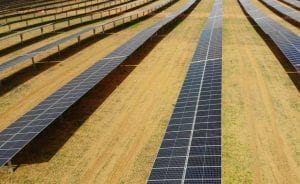Chinese manufacturing giant Trina Solar – now the second largest solar PV manufacturer in the world – says there is little doubt that the cost of solar PV modules will continue to fall. It’s just that the price to consumers will no longer be following it down.
Pierre Verlinden, the chief scientist and vice-president of Trina, says solar PV costs will continue to fall as they have done – by around 20 per cent for every doubling in global cumulative production.
The issue for consumers now is that because cumulative production is nearing 200GW, the next doubling will take longer than the previous. So it may translate into a 5-6 per cent reduction each year.
And as the rationalization of the manufacturing industry continues, then producers will take advantage of lifting their margins to make their business profitable and sustainable. So prices may not rise, but they are unlikely to come down much anytime soon.
Verlinden, in Australia for a series of company-sponsored presentations to the Australian solar industry, notes another important change in the market – a flight to quality products.
“The great price decline is over. Customers used to be focused on what was cheapest, now they want the best quality,” he told RenewEconomy in an interview. “That is new, but I am glad for that. It is good for the industry.”
This is important because the levellised cost of electricity is highly influenced by the efficiency, and the longevity, of the module, as this graph below suggests.
Indeed, while Trina has a long term target LCOE of 6c/kWh, which would put it on par with most gas-fired generators, even in the US, that will depend on the efficiency gains – even more so than the manufacturing cost reductions. Both, though, will be important.
While most components of modules, such as silicon and wafers, and cell production, has fallen, some aspects have increased. This includes the cost of silver and labour costs, while aluminium has held around steady. The solar industry is the biggest industrial consumer of silver, and the price is rising accordingly. This is encouraging manufacturers to look at alternatives and increasing automation.
Verlinden also made some other interesting points. One is on the energy pay-back time for solar modules. He estimates it is currently around 1.5 years in the best solar regions, and about 3-4 years in the worst solar regions. He says it needs to get below a one year payback time.
The carbon footprint of the technology is also critical – and also influenced by the longevity of the product.
This graph shows how it compares with other key technologies. Trina puts its carbon footprint at 19g of CO2-e for ever kWh. That compares favourably with all technologies except for hydro.
The other challenge for the solar industry – particularly as solar PV penetrates further into the electricity market, and the business models of utilities – is on the issue of reliability and grid services.
Verlinden says it is critically important for solar to be able to provide voltage as well as power. That is where storage and smart grids will be critical.
“Pretty much all over the world, utilities have a big fear of a large penetration from solar PV. They are losing revenue.
“The main criticism is that solar PV is disruptive to grid. We need to address that and work with the utilities. We shouldn’t fight with the utility, we should be partners, if they want to be.
“We know that we need to work on storage. Solar PV is the point where the penetration is big enough to create worries about dispatching that energy. So we need to integrate that with right inverters, with smart grid technology, and with efficient storage.”










